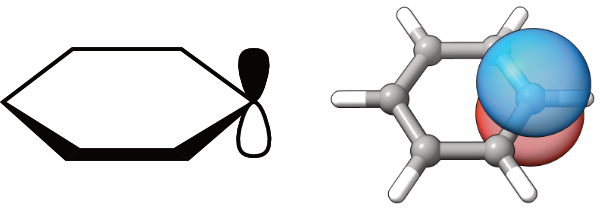from rdkit import Chem
from rdkit.Chem import AllChem
smiles = "c1ccccc1"
mol = Chem.MolFromSmiles(smiles)
mol = Chem.AddHs(mol)
mol
How to compute and visualize natural atomic orbitals with PySCF
Sometimes we need to display atomic type orbitals in a schematic way to visualize simple concepts. The molecular orbitals or even localized orbitals are then overly complex. Simple examples are the ChemDraw-style orbitals, which are used to rationalize reactions in organic chemistry. Now, is it possible to obtain similar orbitals, but in 3D?

We will use benzene as an example. First we generate the 3D coordinates using RDKit
from rdkit import Chem
from rdkit.Chem import AllChem
smiles = "c1ccccc1"
mol = Chem.MolFromSmiles(smiles)
mol = Chem.AddHs(mol)
mol
We visualize the structure using py3Dmol
We will now use PySCF to calculate the NAOs. As we are only interested in the schematic form of the orbitals, the small STO-3G basis set will be sufficient. First we construct the PySCF Mole object from the RDKit Mol object.
import pyscf
from pyscf import gto, lo, tools, dft
elements = [atom.GetSymbol() for atom in mol.GetAtoms()]
coordinates = mol.GetConformer().GetPositions()
atoms = [(element, coordinate) for element, coordinate in zip(elements, coordinates)]
pyscf_mole = gto.Mole(basis="sto-3g")
pyscf_mole.atom = atoms
pyscf_mole.build();We then run the DFT calculation, which is actually quite fast
We can now compute the NAOs from the 1-st order reduced density matrix. Note that we are here actually calculating the pre-orthogonal NAOs (PNAOs) that are even more local that the NAOs. We the write the PNAOs to cube files - these files can be quite large, ca 3 MB each.
Here we use py3Dmol and ipywidgets to interactively view the orbitals.
def draw_orbital(view, i):
with open(f"./benzene_nao_{i:02d}.cube") as f:
cube_data = f.read()
view.addVolumetricData(cube_data, "cube", {'isoval': -0.04, 'color': "red", 'opacity': 0.75})
view.addVolumetricData(cube_data, "cube", {'isoval': 0.04, 'color': "blue", 'opacity': 0.75})
view.addModel(Chem.MolToMolBlock(mol), 'mol')
view.setStyle({'stick':{}})
view.zoomTo()
view.update()
view.clear()
view = py3Dmol.view(width=400,height=400)
view.show()
draw_orbital(view, 25)You appear to be running in JupyterLab (or JavaScript failed to load for some other reason). You need to install the 3dmol extension:
jupyter labextension install jupyterlab_3dmol
Unfortunately, the interactive viewer doesn’t display on the blog. Try running the code below on Binder or locally on your machine.
from ipywidgets import fixed, interact_manual
n_orbitals = naos.shape[1]
view = py3Dmol.view(width=400,height=400)
view.show()
interact_manual(draw_orbital, view=fixed(view), i=(1, n_orbitals));You appear to be running in JupyterLab (or JavaScript failed to load for some other reason). You need to install the 3dmol extension:
jupyter labextension install jupyterlab_3dmol
iwatobipen’s blog post on the rendering of orbitals with py3Dmol was very helpful when writing this notebook.
---
title: "Visualizing atomic type orbitals in molecules"
subtitle: "How to compute and visualize natural atomic orbitals with PySCF"
date: "2022-06-30"
categories: ["quantum chemistry"]
image: "orbitals.png"
aliases: ["../../quantum_chemistry/2022/06/30/Visualizing-atomic.html"]
jupyter: python3
---
# Introduction
Sometimes we need to display atomic type orbitals in a schematic way to visualize simple concepts. The molecular orbitals or even localized orbitals are then overly complex. Simple examples are the ChemDraw-style orbitals, which are used to rationalize reactions in organic chemistry. Now, is it possible to obtain similar orbitals, but in 3D?
{ width=50% }
# Computing the 3D structure
We will use benzene as an example. First we generate the 3D coordinates using RDKit
```{python}
from rdkit import Chem
from rdkit.Chem import AllChem
smiles = "c1ccccc1"
mol = Chem.MolFromSmiles(smiles)
mol = Chem.AddHs(mol)
mol
```
```{python}
AllChem.EmbedMolecule(mol)
AllChem.MMFFOptimizeMolecule(mol);
```
We visualize the structure using py3Dmol
```{python}
import py3Dmol
v = py3Dmol.view()
v.addModel(Chem.MolToMolBlock(mol), 'mol')
v.setStyle({'stick':{}});
```
# Calculating the NAOs
We will now use PySCF to calculate the NAOs. As we are only interested in the schematic form of the orbitals, the small STO-3G basis set will be sufficient. First we construct the PySCF Mole object from the RDKit Mol object.
```{python}
import pyscf
from pyscf import gto, lo, tools, dft
elements = [atom.GetSymbol() for atom in mol.GetAtoms()]
coordinates = mol.GetConformer().GetPositions()
atoms = [(element, coordinate) for element, coordinate in zip(elements, coordinates)]
pyscf_mole = gto.Mole(basis="sto-3g")
pyscf_mole.atom = atoms
pyscf_mole.build();
```
We then run the DFT calculation, which is actually quite fast
```{python}
mf = dft.RKS(pyscf_mole)
mf.xc = 'b3lyp'
mf.run();
```
We can now compute the NAOs from the 1-st order reduced density matrix. Note that we are here actually calculating the pre-orthogonal NAOs (PNAOs) that are even more local that the NAOs. We the write the PNAOs to cube files - these files can be quite large, ca 3 MB each.
```{python}
dm = mf.make_rdm1()
naos = lo.nao.prenao(pyscf_mole, dm)
for i in range(naos.shape[1]):
tools.cubegen.orbital(pyscf_mole, f'benzene_nao_{i+1:02d}.cube', naos[:,i], nx=60, ny=60, nz=60)
```
# Visualizing the NAOs
Here we use py3Dmol and ipywidgets to interactively view the orbitals.
```{python}
def draw_orbital(view, i):
with open(f"./benzene_nao_{i:02d}.cube") as f:
cube_data = f.read()
view.addVolumetricData(cube_data, "cube", {'isoval': -0.04, 'color': "red", 'opacity': 0.75})
view.addVolumetricData(cube_data, "cube", {'isoval': 0.04, 'color': "blue", 'opacity': 0.75})
view.addModel(Chem.MolToMolBlock(mol), 'mol')
view.setStyle({'stick':{}})
view.zoomTo()
view.update()
view.clear()
view = py3Dmol.view(width=400,height=400)
view.show()
draw_orbital(view, 25)
```
## Interactive viewing
Unfortunately, the interactive viewer doesn't display on the blog. Try running the code below on Binder or locally on your machine.
```{python}
from ipywidgets import fixed, interact_manual
n_orbitals = naos.shape[1]
view = py3Dmol.view(width=400,height=400)
view.show()
interact_manual(draw_orbital, view=fixed(view), i=(1, n_orbitals));
```
# Acknowledgements
iwatobipen's [blog post](https://iwatobipen.wordpress.com/2020/03/07/rendering-molecular-orbital-on-jupyter-notebook-psikit-py3dmol-rdkit-memo/) on the rendering of orbitals with py3Dmol was very helpful when writing this notebook.